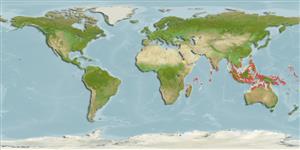>
Siluriformes (Catfishes) >
Ariidae (Sea catfishes) > Ariinae
Etymology: Arius: Greek, arios, areios = dealing with Mars, warlike, bellicose (Ref. 45335).
More on author: Valenciennes.
Environment: milieu / climate zone / depth range / distribution range
Ecologia
marino; salmastro demersale; non migratori; distribuzione batimetrica 0 - 20 m (Ref. 43081). Tropical
Indo-West Pacific: Pakistan east to Thailand then south to the Philippines and Indonesia.
Size / Peso / Age
Maturity: Lm ? range ? - ? cm
Max length : 39.5 cm NG maschio/sesso non determinato; (Ref. 43081); common length : 12.0 cm TL maschio/sesso non determinato; (Ref. 3290)
Found in marine waters, as well as estuaries and tidal rivers, at times burrowed in the soft mud of the mangroves. Feed mainly on invertebrates. Males incubate the eggs in the buccal cavity (Ref. 43081). The sharp dorsal and pectoral fin spines can inflict painful wounds. Also caught with dipnets and set bagnets. Sold mostly fresh.
Males incubate the eggs in the buccal cavity.
Jayaram, K.C., 1984. Ariidae. In W. Fischer and G. Bianchi (eds.) FAO species identification sheets for fishery purposes. Western Indian Ocean fishing area 51. Vol. 1. FAO, Rome. pag. var. (Ref. 3290)
IUCN Red List Status (Ref. 130435)
Threat to humans
Traumatogenic (Ref. 3290)
Human uses
Pesca: commerciale
Informazioni ulteriori
BibliografiaAcquacolturaProfilo di acquacolturaVarietàGeneticaElectrophoresesEreditarietàMalattieElaborazioneNutrientsMass conversion
CollaboratoriImmaginiStamps, Coins Misc.SuoniCiguateraVelocitàModalità di nuotoArea branchialeOtolithsCervelliVista
Strumenti
Special reports
Download XML
Fonti Internet
Estimates based on models
Preferred temperature (Ref.
123201): 27.4 - 29.3, mean 28.7 °C (based on 1689 cells).
Phylogenetic diversity index (Ref.
82804): PD
50 = 0.5000 [Uniqueness, from 0.5 = low to 2.0 = high].
Bayesian length-weight: a=0.00776 (0.00492 - 0.01225), b=2.98 (2.85 - 3.11), in cm total length, based on LWR estimates for this species & (Sub)family-body (Ref.
93245).
Trophic level (Ref.
69278): 2.8 ±0.31 se; based on food items.
Resilienza (Ref.
120179): Basso, tempo minimo di raddoppiamento della popolazione 4.5 - 14 anni (Fec=25-35).
Fishing Vulnerability (Ref.
59153): Moderate vulnerability (35 of 100).
